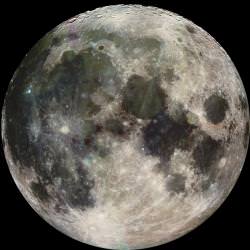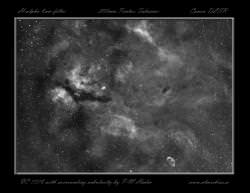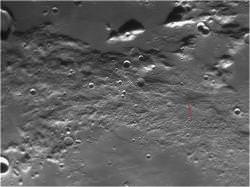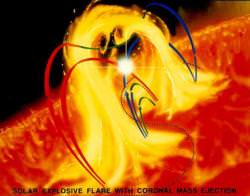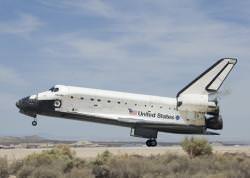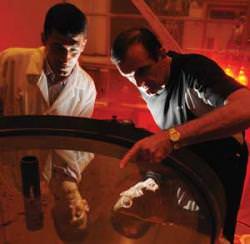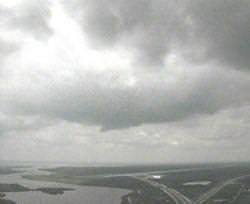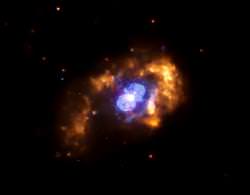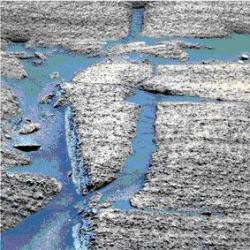Monday, June 25 – Today celebrates the birth of Hermann Oberth – who has often been considered the father of modern rocketry. Born in Transylvania in 1894, Oberth was a visionary who was convinced space travel would one day be possible. Inspired by the works of Jules Verne, Oberth studied rockets and wrote many books devoted to the possibility of achieving spaceflight. He was the first to conceive of rocket “stages” – allowing vehicles to expend their fuel and lose dead weight. But tonight you won’t need one of Oberth’s rockets to travel to the Moon, as we look at the northeast shore of Mare Cognitum and the Apollo 14 mission landing site – Fra Mauro.
As craters go, 3.9 billion year old Fra Mauro is on the shallow side and spans 95 kilometers. At some 730 meters deep, standing at one of its walls would be like standing at the bottom of the Grand Canyon… Yet, time has so eroded this crater that its west wall is completely missing and its floor is covered with fissures.
Even though ruined Fra Mauro seems like a foreboding place to land a manned mission, it remained high on the priority list because it is geologically rich. Ill-fated Apollo 13 was to land in a formation north of the crater formed by ejecta belonging to the Imbrium Basin – material that had already been mapped telescopically. By returning samples of this material from deep within the Moon’s crust, scientists could then determine the exact time these changes came about.
As you view Fra Mauro tonight, picture yourself in a lunar rover traversing this barren ground and rock-strewn landscape thrown out from a long-ago impact. How willing would you be to take on the vision of Oberth and travel to another world?
Tuesday, June 26 – On this day in 1949, asteroid Icarus was discovered on a 48-inch Schmidt plate made nine months after that telescope went into operation, and just prior to the beginning of the multi-year National Geographic-Palomar Sky Survey. The asteroid was found to have a highly eccentric orbit and a perihelion distance of just 27 million kilometers, closer to the Sun than Mercury, giving it its unusual name. It was just 6.4 million kilometers from Earth at the time of discovery, and variations in its orbital parameters have been used to determine Mercury’s mass and test Einstein’s theory of general relativity.
But, today is even more special because it is the birthday of none other than Charles Messier, the famed French comet hunter. Born in 1730, Messier is best known for cataloging the 100 or so bright nebulae and star clusters that we now refer to as the Messier objects. The catalog was intended to keep both Messier and others from confusing these stationary objects with possible new comets.
Tonight let’s venture towards the south shore of Palus Epidemiarum to have a high power look at crater Capuanus. Named for Italian astronomer Francesco Capuano di Manfredonia, this 60 kilometer wide crater boasts a still tall southwest wall, but the northeast one was destroyed by lava flow. At its highest, it reaches around 1900 meters above the lunar surface, yet drops to no more than 300 meters at the lowest. Look for several strikes along the crater walls as well as more evidence of a strong geological history. To its north is the Hesiodus Rima…a huge fault line that extends 300 kilometers across the surface!
Now see how many Messier objects that you can capture and wish Charles a happy 263rd birthday!
Wednesday, June 27 – As we wait on the sky to darken tonight, let’s start our adventures by taking a close look at crater Kepler. Situated just north of central along the terminator tonight, this great crater named for Johannes Kepler only spans 32 kilometers, but drops to a deep 2750 meters below the surface. This class I crater is a geological hotspot!
As the very first to be mapped by the U.S. Geological Survey, the area around Kepler contains many smooth lava domes that extend no more than 30 meters or so above the plains. According to records, in 1963 a glowing red area was spotted near Kepler and extensively photographed. Normally one of the brightest regions of the Moon, the brightness value at the time nearly doubled! Although it was rather exciting, scientists later determined the phenomenon was caused by high energy particles from a solar flare reflecting from Kepler’s high albedo surface. In the days ahead all details around Kepler will be lost, so take this opportunity to have a good look at one awesome small crater!
When skies are dark, it’s time to have a look at the 250 light-year distant silicon star Iota Librae. This is a real challenge for binoculars – but not because the components are so close. In Iota’s case, the near 5th magnitude primary simply overshadows its 9th magnitude companion! In 1782, Sir William Herschel measured them and determined them to be a true physical pair. Yet, in 1940 Librae A was determined to have an equal magnitude companion only .2 arc seconds away…. And the secondary was proved to have a companion of its own that echoes the primary. A four star system!
While you’re out, keep a watch for a handful of meteors originating near the constellation of Corvus. The Corvid meteor shower is not well documented, but you might spot as many as ten per hour.
Thursday, June 28 – Are you ready to study the Moon again tonight? Be sure to look for the “Cow Jumping over the Moon” – but power up with a telescope to study some very wild looking features – lunar lava domes.
North of Aristarchus, west of Promontorium Heraclides, and near the terminator is Rumker – the largest of the lunar lava domes. Only visible when near the terminator, this roughly 77 kilometer diameter “soft hill” ranges anywhere from 60 to 760 meters tall. Although it is not much more than a bump on the lunar surface, it does contain a few summit craters at its highest points. What we are looking at is really an important part of the geology which shaped the Moon’s surface. In all likelihood, Rumker is a shield volcano…in an area of many!
Now continue east towards the prominent crater Marian set in a bright peninsula extending into Sinus Roris and Mare Imbrium. Just southwest are two more – Mons Gruithuisen Gamma (the “Megadome”) and Mons Gruithuisen Delta. While you might not find these features particularly impressive, consider that we’re looking at something only 20 kilometers wide and only meters high!
When you’re finished with your lunar observations, tonight let’s try a challenging double star – Upsilon Librae. This beautiful red star is right at the limit for a small telescope, but quite worthy as the pair is a widely disparate double. Look for the 11.5 magnitude companion to the south in a very nice field of stars!
Friday, June 29 – Today we celebrate the birthday of George Ellery Hale, who was born in 1868. Hale was the founding father of the Mt. Wilson Observatory. Although he had no education beyond his baccalaureate in physics, he became the leading astronomer of his day. He invented the spectroheliograph, coined the word astrophysics, and founded the Astrophysical Journal and Yerkes Observatory. At the time, Mt. Wilson dominated the world of astronomy, confirming what galaxies were and verifying the expanding universe cosmology, making Mt. Wilson one of the most productive facilities ever built. When Hale went on to found Palomar Observatory, the 5-meter (200″) telescope was named for him and dedicated on June 3, 1948. It continues to be the largest telescope in the continental United States.
Now let’s go deep south and have look at an area which once held something almost half a bright as tonight’s Moon and over four times brighter than Venus. Only one thing could light up the skies like that – a supernova.
According to historical records from Europe, China, Egypt, Arabia and Japan, 1001 years ago the very first supernova event was noted. Appearing in the constellation of Lupus, it was at first believed to be a comet by the Egyptians, yet the Arabs saw it as an illuminating “star.”
Located less than a fingerwidth northeast of Beta Lupus (RA 15 02 48.40 Dec -41 54 42.0) and a half degree east of Kappa Centaurus, no visible trace is left of a once grand event that spanned five months of observation beginning in May, and lasting until it dropped below the horizon in September, 1006. It is believed all the force created from the event was converted to energy and very little mass remains. In the area, a 17th magnitude star shows a tiny gas ring and radio source 1459-41 remains our best candidate for pinpointing this incredible event.
Saturday, June 30 – Tonight is the Full Moon – but is it Blue? According to modern folklore, anytime there is a second Full Moon within one calendar month it’s called “blue.” The explanation of the term is a rather long one involving old almanacs, mistakes in literary sources, and even urban legend. No matter if the definition is right or wrong, we can still enjoy a relatively rare occurrence – but how rare is it?
Most of the time a calendar month will only have one Full Moon, yet it’s a given that any event separated by 29 days will eventually catch up to calendar time – around every two and half years. Chances are good that you’ll only see the same pearl colored Moon as always when it rises – but if your area is affected by volcanic eruptions or forest fires – it just might be blue! (But then you’d best be running and not out Moongazing…) This is caused by the light scattering properties of small particles in the atmosphere – much like what causes our daylight skies to be blue, or noctilucent clouds to have their strange colors.
Still got the blues? Then try your hand at a super challenging double – Mu Librae. This pair is only a magnitude apart in brightness and right at the limit for a small telescope. Up the power slowly and look for the companion just to the southwest of the primary. Good luck and mark your observation because Mu’s blues are on many observing lists!
And out of the blue comes a meteor shower! Keep watch tonight for the June Draconids. The radiant for this shower will be near handle of Big Dipper – Ursa Major. The fall rate varies from 10 to 100 per hour, but tonight’s bright skies will toast most of the offspring of comet Pons-Winnecke. On a curious note, today in 1908 was when the great Tunguska impact happened in Siberia. A fragment of a comet, perhaps?
Sunday, July 1 – Today In 1917, the astronomers at Mt. Wilson were celebrating as the 100″ primary mirror arrived. Up until that time, the 60″ Hale telescope (donated by George Hale’s father) was the premier creation of St. Gobrain Glassworks – which was later commissioned to create the blank for the Hooker telescope. Thanks to the funds provided by John D. Hooker (and Carnegie), the dream was realized after years of hard work and ingenuity to create not only a building to properly house it – but the telescope workings as well. It saw “first light” five months later on November 1.
As anxious astronomers waited for this groundbreaking moment, the scope was aimed at Jupiter but the image was horrible – to their dismay, workmen had left the dome open and the Sun had heated the massive mirror! Try as they might to rest until it had cooled – no astronomer slept. Fearful of the worst, sometime around three in the morning they returned again long after Jupiter had set. Pointing the massive scope towards a star, they achieved a perfect image!
Tonight start your stargazing evening off right by having a look at the western skyline at twilight. Venus and Saturn are waltzing together less than a degree apart! Not only is this an eye appealing conjunction to the unaided observer, but a wonderful opportunity to see both planets at once in the same low power telescope field!
While you’re out, take the time to look at lowly Theta Lupi about a fistwidth south-southwest of the mighty Antares. While this rather ordinary looking 4th magnitude star appears to be nothing special – there’s a lesson to be learned here. So often in our quest to look at the bright and incredible – the distant and the impressive – we often forget about the beauty of a single star. When you take the time to seek the path less traveled, you just might find more than you expected. Hiding behind a veil of the “ordinary” lies a trio of three spectral types and three magnitudes in a diamond-dust field. An undiscovered gem….

